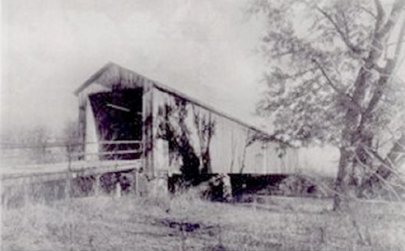|
Locust Creek Covered Bridge |
|
Bridge, ca 1920's |
|
On August 4, 1868, the Linn County Commissioners awarded a contract to the firm of Bishop & Eaton for construction of a covered bridge at a cost "not to exceed $5,000". The 151 foot structure, originally known as the Linn County Bridge, was completed and opened to traffic the same year. It is the longest of the four surviving covered bridges in the state. The bridge was built with the Howe-truss system and features arched entrances with ramps sloping away from both ends. It was situated on the main east-west road in northern Missouri, running parallel to the Hannibal and St. Joseph Railroad. Midway between Laclede and Meadville, Locust Creek Covered Bridge served a local population. The road on which the bridge was located later became Route 8, the nation's first transcontinental highway. Locust Creek's channel was altered following World War II, leaving the bridge spanning a dry creek bed, and U. S. Highway 36 replaced Route 8 as the main traffic artery across Northern Missouri. By 1960 the county had ceased maintaining of the west access road, and the bridge became virtually inaccessible. |
|
....3 miles west of Laclede on Hwy. 36, 1 mile north, then east 518 of a mile on unmarked, gravel road. Harboring many memories from years gone by, the Linn County Covered Bridge spans the now dry Locust Creek. The bridge is also well known as the Locust Creek Covered Bridge. Realizing the need for the bridge, the Linn County Court ordered the construction of a covered bridge across Locust Creek on the road from Brookfield to Collyers Mill (no longer in existence) on May 19, 1868. The bridge was to be erected “at a cost not exceeding $5,500.” The contract for construction of the bridge was awarded to the firm of Bishop and Eaton by the county court on August 4, 1868. The bridge measures 20 feet, 3 inches high and is 151 feet long and 16 feet, 8 inches wide. The long axis of the bridge is oriented northeast-southwest. In May, 1968 the Linn County Covered Bridge became the responsibility of the Missouri State Park Board, and restoration of the bridge was completed that year. Repairs included the replacement of the roof, sheeting, sideboards and flooring. The bridge is closed to vehicular traffic because the road terminates at the bridge. |


